Common Name(s): Chechen, black poisonwood, Caribbean rosewood
Scientific Name: Metopium brownei
Distribution: Dominican Republic, Cuba, Jamaica, Guatemala, Belize, and southeastern Mexico
Tree Size: 50-115 ft (15-35 m) tall,
3-5 ft (1-1.5 m) trunk diameter
Average Dried Weight: 55.0 lbs/ft3 (880 kg/m3)
Specific Gravity (Basic, 12% MC): 0.78, 0.88
Janka Hardness: 2,400 lbf (10,670 N)
Modulus of Rupture: 13,490 lbf/in2 (93.0 MPa)
Elastic Modulus: 2,253,000 lbf/in2 (15.53 GPa)
Crushing Strength: 8,270 lbf/in2 (57.0 MPa)
Shrinkage: Radial: 3.8%, Tangential: 6.8%,
Volumetric: 10.6%, T/R Ratio: 1.6
Color/Appearance: Heartwood color is highly varied, with red, orange, and brown contrasted with darker stripes of blackish brown. Color tends to shift to a darker reddish brown with age. Well defined sapwood is a pale yellow
Grain/Texture: Grain is usually straight, but may be wild or interlocked. With a uniform medium to fine texture and good natural luster.
Rot Resistance: Rated as being very durable, and moderately resistant to most insect attacks.
Workability: Fairly easy to work, but tearout may occur when machining pieces with interlocked grain. Glues and finishes well, though because of its density and tendency to split, nails and screws should be pre-bored.
Odor: No characteristic odor.
Allergies/Toxicity: Although severe reactions are quite uncommon, chechen has been reported as a sensitizer. Usually most common reactions simply include eye and skin irritation. See the articles Wood Allergies and Toxicity and Wood Dust Safety for more information.
Pricing/Availability: Generally available as lumber, though turning blanks and thin craft lumber is also sold. Chechen is touted as a low-cost substitute for more expensive tropical woods, and prices should be moderate for an imported hardwood.
Sustainability: This wood species is not listed in the CITES Appendices or on the IUCN Red List of Threatened Species.
Common Uses: Veneer, furniture, cabinetry, flooring, turned objects, and small specialty wood items.
Comments: Because of its density, natural luster, and beautiful coloration, chechen is sometimes referred to as Caribbean rosewood, though it is not a true rosewood in the Dalbergia genus. However, this alternate common name is understandable given the (totally unrelated) negative connotations that the name “Chechen” received in the mid 1990s in Eastern Europe.
Another alternate name, black poisonwood, comes from its toxic sap, which turns black and causes severe skin reactions similar to poison ivy. Both species are classified in the Anacardiaceae (cashew) family—a family containing many allergenic or otherwise harmful species. However, the wood itself is safe to handle, though there are some allergenic reactions associated with the wood dust.
Images: Drag the slider up/down to toggle between raw and finished wood.
Identification: See the article on Hardwood Anatomy for definitions of endgrain features.
Porosity: diffuse porous
Arrangement: solitary and radial multiples
Vessels: medium to large, few; tyloses and reddish brown deposits abundant
Parenchyma: vasicentric and lozenge; sometimes with very faint banded (marginal) parenchyma as seen in this sample
Rays: narrow to medium width; normal spacing
Lookalikes/Substitutes: Chechen wood with good color and figure have a unique appearance that’s not easily confused with other woods. However, pieces with blander or more ambiguous color or grain may be confused with other diffuse-porous tropical hardwoods. The lack of odor when being worked, as well as its fluorescent response under a blacklight can both serve to distinguish chechen from some lookalikes.
Notes: Heartwood fluoresces a streaked green under a blacklight.
Related Content:

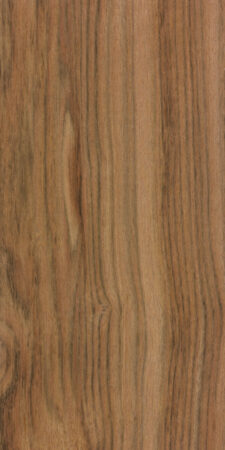

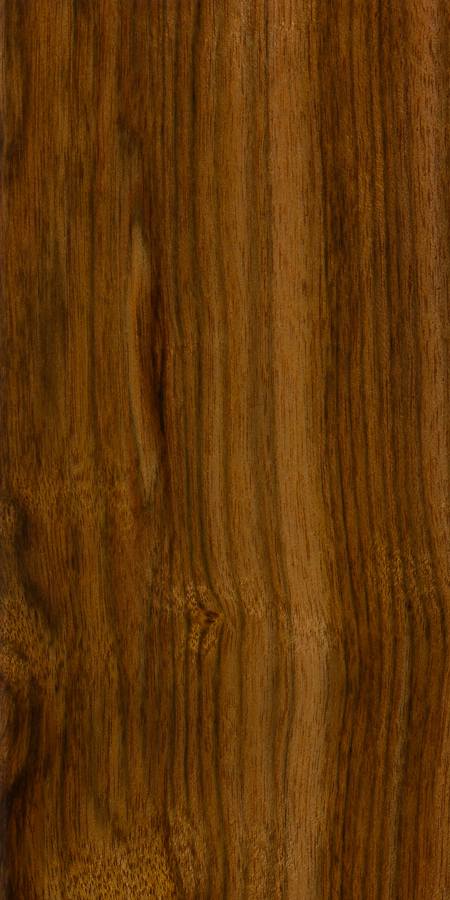

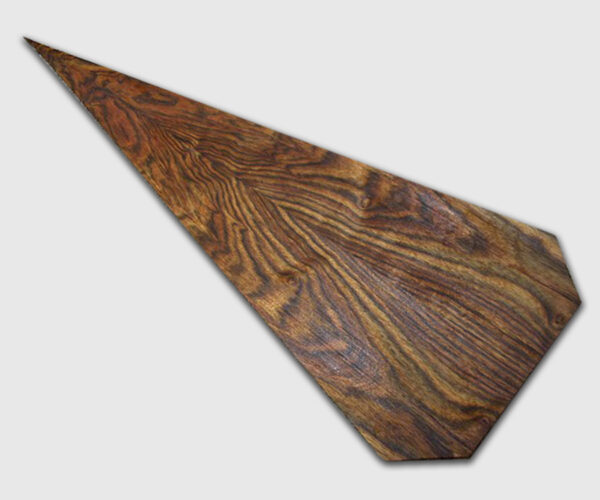




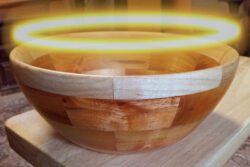
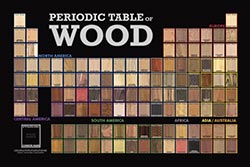
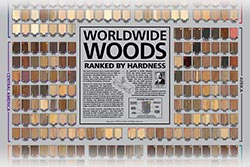




Hi, I have been gifted two Chechen chairs. Wondering if they would be suitable to use on a covered porch or deck?
Chechen top on my bass guitar. (Modulus Quantum 5-string)
I love this wood! My first time turning it and it’s great.
Hi guys, I am trying to figure out how to measure the moisture level in this wood but I can’t find it in my humidity measuring devise the correct wood tile. Does anyone know a similar type of wood to measure accurately?
You can use the basic specific gravity number listed above on this page.
Thanks! Ill look it up.
I just purchased a piece of wood sold as Chechen. I am certain, however, that is not what I received. Using the profile of Chechen on this site the wood does not fit. The end grain is not similar, there is a strong unpleasant odour when worked, and there is no florescence. I am wondering if anyone knows which other woods are sometimes sold under the umbrella of Chechen, as I would like to identify what it is I have purchased. My search online revealed nothing.
I started making rolling pins with Celtic knots out of Chechen (not know it was also called poisonwood. Is it safe to use this Wood for this application?
This is one of favorite lumbers. The color and grain can match or surpass rosewoods and the color doesn’t fade at all. The wood is hard and heavy but not too hard to work.
I made this jewelry box years ago and the wood is still fantastic.
I would like to panel a wall about 9ft x13ft would this wood work well for this application
Turned bowl from Chechen
Hello, my father has poisonwood trees on his land in South Florida. He had an extremely severe reaction to the sap. I had a small patch that got on me. I used to work at a history museum and these trees were part of the nature tour I gave. I really appreciate them but I feel we need to take these trees out after it started effecting us. I don’t like that because they are very old and I wish they could be preserved. However I will be building a tiny house and I would like to harvest the wood.… Read more »
What do you mean “No characteristic odor”?!… If you have ever worked with this wood you will know that it definitely had a characteristic odor, that only smells like Chechen.
Did you by chance work with it when green, as a turning blank perhaps? I don’t ever remember this wood having a distinct scent when dried.
No, I have only worked with it dried. I was just sanding a stack of Chechen pen blanks on my 6″ x 48″ belt sander and the warm sawdust quickly filled my shop with the smell of Chechen. Here is a picture of some of the pen blanks I was sanding. To me it has a very distinct smell, like Cocobolo or Amboyna burl, where you could name the wood just by the smell. Am I the only person to smell this?
Can you get a closeup shot of the endgrain (finely sanded)? It may be that you really do have rosewood that’s been misidentified. It should be pretty easy to tell endgrain of chechen apart from true rosewoods if you can get a clear enough look at it.
I sanded it to 400g and hit it with a buffer. I laid it out so you can see the endgrain (top) and what it looks like close to a knot (bottom). I hope this helps. I have many different types of rosewood blanks but this is a very different color… but I know there are many types of rosewood I haven’t seen. Thank you for your help.
The funny thing is that the wood appears fairly burly (or at least the pen blanks were cut at an off-angle) — so much so that the “endgrain” of the blanks isn’t really endgrain at all. But I can see an endgrain pattern in the second picture on the blank that is underneath the top piece, and it does not appear to be chechen. In the endgrain, you can pretty clearly make out parenchyma bands, which chechen does not have. https://www.wood-database.com/wood-articles/hardwood-anatomy/#paratracheal (Also, rosewoods and a large amount of other tropical hardwoods do have banded parenchyma.) Also, color with rosewoods can… Read more »
Can anyone let me know if it is a good idea to carve a kuksa out of this wood?
Is the smoke when cutting it harmful?
all wood smoke is harmful to some degree
Can this be used in a cutting board? Since an alternate name for this is black poisonwood, I have some concerns using this wood.
of course
You could use it, toxicity wise. But it’s very hard, would probably damage your knife edges.
I had a notion to use this for the back/bowl of a lute. Any opinions? How would you think it would work as the back-and-sides of a plucked instrument such as a guitar?
G&L uses it for guitar and bass fretboards…if that helps you any.
Chechen is definitely dense and heavy. This is a snare drum that I built using the stave build method. Despite the hardness of the wood it worked very nicely with clean saw cuts no issues of tear out from the router. The toughest part was the finishing process. I think this wood should be included in the Finishing Exotic And Tropical Hardwoods” article here on the database. I had to strip my first attempt at applying water based polyurethane clear gloss. My first coat went on ok but anything after that would bead up like a freshly waxed car hood.… Read more »
Beautiful drum Ben!
Anyone think I can run it a plainer?
It planes very well
Somewhat from what I have see. Tighter grain and heavier as are most rosewoods.
this is not a true Rosewood
Can someone please explain why this kind of wood is called Chechen?
The original name is Chechen because the wood is harvested in Central America, I think it is a Mayan name.
One of the heaviest woods I’ve encountered, and just about impossible to laser cut on a mid-range machine.
The wood itself is safe to handle, though there are some
allergenic reactions associated with the wood dust.